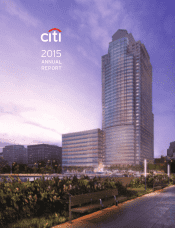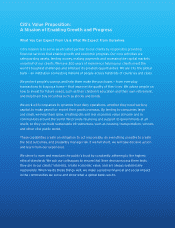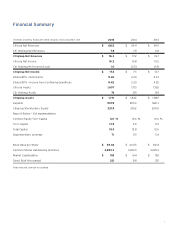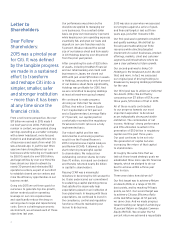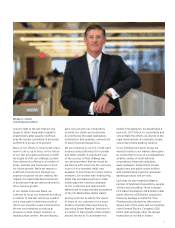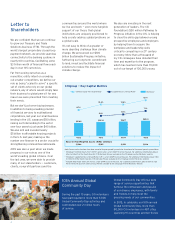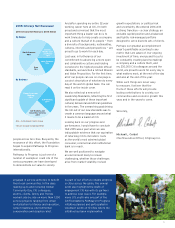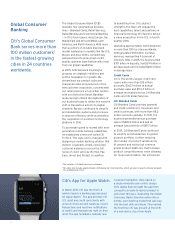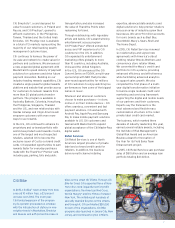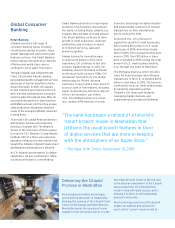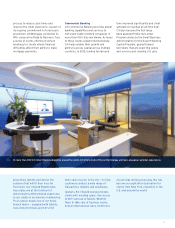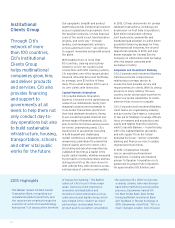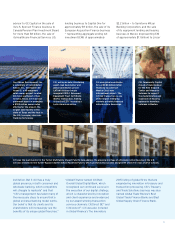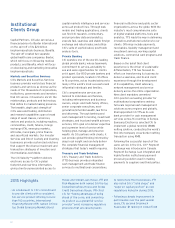Citibank 2015 Annual Report Download - page 4
Download and view the complete annual report
Please find page 4 of the 2015 Citibank annual report below. You can navigate through the pages in the report by either clicking on the pages listed below, or by using the keyword search tool below to find specific information within the annual report.Our performance was driven by the
discipline we applied to managing our
core businesses. On a constant dollar
basis, we grew our revenues by 3 percent,
while keeping our core operating expenses
essentially flat, and grew our loans and
deposits in our core franchise each by
5 percent. We also reduced the overall
size of our balance sheet and took assets
in Citi Holdings down by over 40 percent
from the prior year period.
After completing the sale of $32 billion
of assets, including OneMain Financial
and our retail banking and credit card
businesses in Japan, we closed out
2015 with just under $75 billion in assets
in Holdings, amounting to only 4 percent
of our balance sheet. More significantly,
Holdings was profitable for 2015. And
we are committed to keeping Holdings
at least at break-even going forward.
We continued to make progress
utilizing our Deferred Tax Assets
(DTAs). And with a Common Equity
Tier 1 Capital Ratio of 12.1 percent
and a Supplementary Leverage Ratio
of 7.1 percent, our capital position
comfortably exceeded the regulatory
thresholds for both ratios on a fully
implemented basis.
Our robust capital position was
instrumental in achieving a positive
result from the Federal Reserve’s
2015 Comprehensive Capital Analysis
and Review (CCAR). It allowed us to
start returning meaningful capital
to shareholders. We reduced our
outstanding common shares by more
than 70 million, increased our dividend
and thereby returned nearly $6 billion
in capital to shareholders.
Passing CCAR was a meaningful
milestone in becoming the Citi we want to
be. It also underscored our commitment
to sustaining a capital planning process
that satisfies the deservedly high
expectations placed on an institution of
true global reach. In keeping with these
expectations, we continued to invest in
the compliance, control and regulatory
functions critical to maintaining our
license to do business.
Letter to
Shareholders
Dear Fellow
Shareholders:
2015 was a pivotal year
for Citi. It was defined
by the tangible progress
we made in a sustained
effort to transform
and reshape Citi into a
simpler, smaller, safer
and stronger institution
— more than it has been
at any time since the
financial crisis.
From a net income perspective, the over
$17 billion we earned in 2015 made it
our best year since 2006. Putting that
number in context, we generated strong
earnings operating as a smaller company,
with a lower headcount, more focused
footprint, and dramatically different mix
of businesses and assets from what Citi
was a decade ago. In just the last three
years we have strengthened our core
businesses while reducing our headcount
by 28,000, assets by over $130 billion,
and legal entities by over one-third. We
have shrunk our branch network by
nearly 30 percent and eliminated 182
operations centers, as part of our effort
to establish shared service centers and
mine the efficiency opportunities in our
business model.
Going into 2015 we set three goals for
ourselves: to generate top-line growth,
deliver modest positive operating
leverage on our core expense base
and significantly reduce the drag on
earnings due to legal and repositioning
costs. Even in a challenging economic
environment, we achieved each of those
objectives last year.
2015 was also a year when we assessed
our progress against a series of goals
and financial targets I laid out three
years ago, just after I became CEO.
Our first goal was to generate consistent
and quality earnings. We did that by
focusing and reallocating our finite
resources while directing targeted
investments to select businesses, product
offerings, markets, client and customer
segments and infrastructure where we
saw a clear pathway to future growth.
Our second goal was to bring Citi
Holdings to the breakeven point. We did
that, and more. In fact, we surpassed
our original goal of driving Holdings to
breakeven by keeping Holdings profitable
for the year.
Our third goal was to utilize our Deferred
Tax Assets (DTAs). We did that by
consuming over $7 billion of DTAs over
three years, $1.5 billion of that in 2015.
All of these results contributed
to our progress towards our most
important aspiration: to be known
as an indisputably strong and stable
institution. The combination of net
income, Holdings’ strong performance
and DTA utilization resulted in the
generation of $50 billion in regulatory
capital over the past three years.
Our goal continues to be not only
the generation of capital but also
increasing the return of that capital
to shareholders.
At roughly the same time that we
laid out those broad strategic goals we
established three more specific financial
targets, which we pledged to do our
best to achieve within a three-year
time horizon.
Three years later, how did we do?
Our first target was to achieve a Return
on Assets (ROA) in a range of 90–110
basis points, and by reaching 94 basis
points, we hit it. Our second target was
to achieve a Citicorp Efficiency Ratio
in the mid-fifties range. At 57 percent,
we came close. And we made progress
toward meeting our target of achieving a
10 percent Return on Tangible Common
Equity (ROTCE). We consider the 9.2
percent return we achieved a respectable
2

